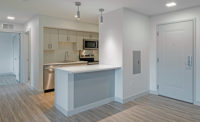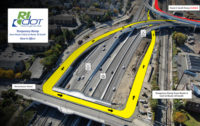Despite the ultimately empty threat of heavy rain from Hurricane Dorian, general contractor John Moriarty and Associates completed what is likely the largest continuous concrete casting ever performed in New England.
Working in collaboration with G&C Concrete, Moriarty's team continuously cast 8,000 cu yd of concrete on Sept. 7 for the $215-million Cambridge Crossing Parcel G project. For the 13-hour placement in East Cambridge, Mass., the team cast 800 yd per hour, and up to 833 yd per hour during peak activity, emptying a truckload every 40 seconds. The 125 concrete truck drivers made seven runs to finish the job.
Estimated to take 14 to 16 hours, Mike George, chief executive office and co-owner of G&C Concrete Construction, said the effort went “even better than we would have expected.”
The team originally planned to begin work at 1 a.m., but due to the timing of the forecasted rain, the team moved the start time to 5 a.m. “Once daylight broke…the site was way easier for the truck drivers to see…,” says Jon Hawkins, safety director at G&C Concrete.
The project, under development by San Francisco-based Divco West Properties began in January is scheduled for a mid-2021 delivery. The 4.5 million-sq-ft development is situated in a 45-acre site on what was an empty railroad yard where Cambridge, Somerville, and Boston intersect. The mixed-use development is one of the largest projects in the Boston metropolitan area. Once complete, it will include 2.1 million sq ft of lab and office space in six buildings, 2,400 condos and 100,000 sq ft of retail space, according to Divco.
The overall crew totaled 100 workers, including G&C supervisors, trades workers, cement finishers, and operators, in addition to testing agency personnel and plumbers and electricians on standby.
G&C’s three suppliers—Boston Sand and Gravel, its primary supplier, Aggregate Industries and JG MacLellan—used eight concrete pumps.
The foundation’s 5,000-psi concrete mat averaging 51/2 ft in depth will support the 14-story, 240-ft-high, 737,000 gross-sq-ft building, including three underground parking levels. The casting, which comprised two thirds of the building’s overall dimensions, includes 6.5 million lb of rebar and 39,000 sq ft of broom-finished slab.
The concrete mat the team placed, “was sloped and broomed because it is the lower level of the garage,” says Bill Wilbur, project superintendent for Moriarity.
The team began monitoring the forecasted path of Dorian a week and a half prior to placement. Once it seemed certain the storm would move up the eastern coastline, “we procured rentals and took delivery of two 21,000-gallon frac tanks and two 4-in diesel pumps to have on standby,” Wilbur says.
The dewatering system for the mass excavation would not have handled an excessive volume “so we needed back up storage in case,” he says. By the evening prior to the placement, the team also installed numerous 2-in pumps in specific areas of the mat slab “to mitigate and remove rainwater in the event of heavy rain.”
The team spent more than a month on site preparation and logistics, working closely with its three concrete suppliers. But as Hurricane Dorian moved up the eastern seaboard on the short Labor Day week, the team had to dive into contingency plans for the casting in the event of an extreme event with heavy rain, Wilbur says.
Setting up a Plan B included receiving city permitting for casting Sunday, June 8, instead of Saturday if necessary and concrete plant buy-in for Sunday. Internally, Moriarity also had a host of pumping and water storage issues to consider, should a major rain even occur, Wilbur says.
The day before the placement, Wilbur and Peter Quigley, principal for structural engineer of record Thornton Tomasetti, assessed whether to stay with the Sept. 7 placement plan.
“We analyzed how the water-cement ratio would be affected if we had one inch of water during this placement,” Wilbur says.
In that event, the team determined it would have resulted in increasing the water-cement ratio of the concrete mix from its 0.40 in the mix design to 0.45, but with only a drizzle, no change was necessary, he says, adding, “We found that, with the number of pumps, generators and back up storage tanks, we could proceed with the forecasted rain without compromising the water-cement ratio the structural engineer required.”
In addition to site planning, logistics and road planning for the cement trucks, the team had a 50-ton hydraulic crane on standby in case someone got hurt, but there were no incidents, Hawkins says.
This story was updated with more information on Sept. 17.






Post a comment to this article
Report Abusive Comment